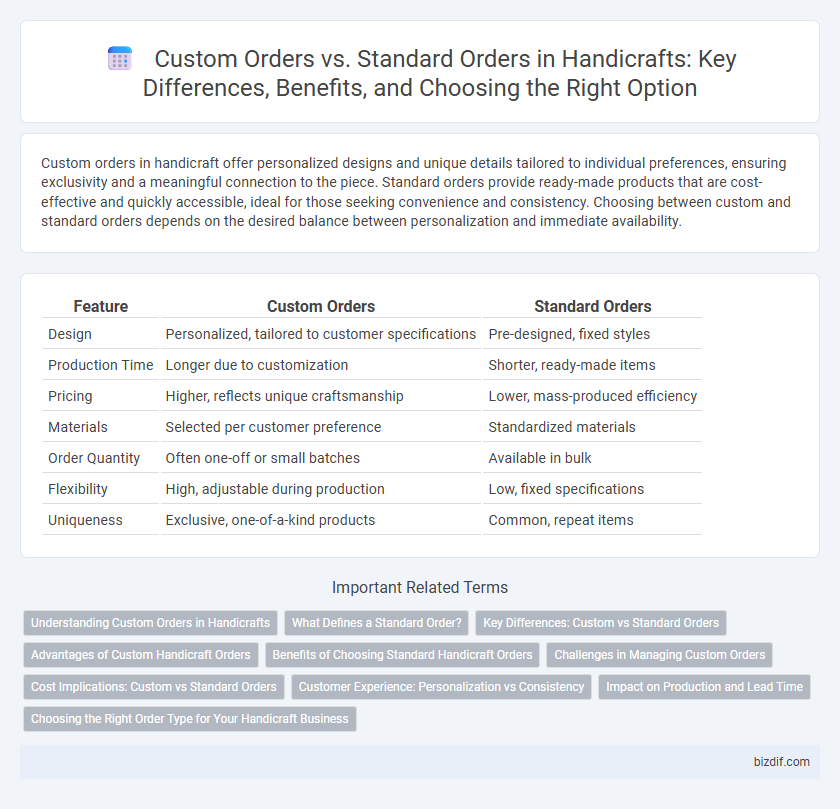Custom orders in handicraft offer personalized designs and unique details tailored to individual preferences, ensuring exclusivity and a meaningful connection to the piece. Standard orders provide ready-made products that are cost-effective and quickly accessible, ideal for those seeking convenience and consistency. Choosing between custom and standard orders depends on the desired balance between personalization and immediate availability.
Table of Comparison
| Feature | Custom Orders | Standard Orders |
|---|---|---|
| Design | Personalized, tailored to customer specifications | Pre-designed, fixed styles |
| Production Time | Longer due to customization | Shorter, ready-made items |
| Pricing | Higher, reflects unique craftsmanship | Lower, mass-produced efficiency |
| Materials | Selected per customer preference | Standardized materials |
| Order Quantity | Often one-off or small batches | Available in bulk |
| Flexibility | High, adjustable during production | Low, fixed specifications |
| Uniqueness | Exclusive, one-of-a-kind products | Common, repeat items |
Understanding Custom Orders in Handicrafts
Custom orders in handicrafts involve personalized creations tailored specifically to a customer's preferences, incorporating unique materials, designs, and dimensions that standard orders cannot offer. These bespoke pieces often require detailed collaboration between the artisan and client to ensure the final product reflects individual style and specific functional needs. Understanding custom orders is essential for artisans to effectively manage client expectations, material sourcing, and production timelines while delivering high-quality, one-of-a-kind handicraft items.
What Defines a Standard Order?
A standard order in handicraft refers to a pre-designed product created in bulk with consistent specifications, materials, and dimensions. These items are ready-made, allowing for faster production and delivery times compared to custom orders. Standard orders prioritize efficiency and uniformity, catering to customers seeking reliable, quickly available handcrafted goods.
Key Differences: Custom vs Standard Orders
Custom orders in handicraft involve personalized designs tailored to individual client specifications, often requiring longer production times and higher costs due to unique materials or intricate craftsmanship. Standard orders consist of pre-designed products made in bulk, ensuring faster turnaround and consistent pricing but limited customization options. The key differences lie in customization level, production time, and pricing flexibility.
Advantages of Custom Handicraft Orders
Custom handicraft orders offer personalized designs tailored to individual preferences, ensuring unique and meaningful creations. These bespoke items often use higher-quality materials chosen specifically for the project, resulting in superior craftsmanship and durability. Custom orders also support artisan creativity and skill, fostering a deeper connection between the maker and the customer.
Benefits of Choosing Standard Handicraft Orders
Standard handicraft orders offer quick turnaround times and consistent quality, ensuring customers receive beautifully crafted items without long delays. These pre-designed products often come at competitive prices due to streamlined production processes, making them budget-friendly options. Choosing standard orders also provides a reliable guarantee of craftsmanship, as artisans refine these designs through repeated creation.
Challenges in Managing Custom Orders
Managing custom orders in handicraft presents distinct challenges including longer production times due to unique specifications and increased communication demands to clarify client preferences. Inventory management becomes complex as materials must be sourced or adapted specifically for each custom design, impacting cost efficiency. Balancing customization with scalability requires precise workflow adjustments to prevent delays and maintain quality, distinguishing it from the streamlined processes of standard orders.
Cost Implications: Custom vs Standard Orders
Custom orders in handicraft typically incur higher costs due to personalized design, unique materials, and extended labor time compared to standard orders, which benefit from economies of scale and streamlined production processes. Handcrafted custom pieces often require specialized skills and additional craftsmanship hours, increasing overall expenses and price points for customers. Standard orders, produced in larger quantities with consistent specifications, minimize cost per unit, making them more affordable but less tailored to individual preferences.
Customer Experience: Personalization vs Consistency
Custom orders in handicraft offer heightened personalization, allowing customers to influence design, materials, and size, resulting in unique products tailored to individual preferences. Standard orders provide consistency, ensuring uniform quality and timely delivery, which appeals to customers seeking reliable and predictable outcomes. Balancing these aspects enhances customer experience by catering to both desire for exclusivity and dependable service.
Impact on Production and Lead Time
Custom orders in handicraft require tailored design and materials, significantly increasing production complexity and extending lead times compared to standard orders. Standard orders benefit from streamlined processes and pre-set inventories, allowing faster turnaround and consistent quality. Production management must balance customization demands with efficiency to optimize workflow and meet delivery expectations.
Choosing the Right Order Type for Your Handicraft Business
Custom orders in handicraft businesses allow for personalized creations tailored to specific customer preferences, enhancing customer satisfaction and potentially commanding higher prices. Standard orders streamline production with predefined designs, enabling faster turnaround times and consistent inventory management. Selecting between custom and standard orders depends on balancing creative flexibility, production capacity, and market demand to optimize business growth.
Custom Orders vs Standard Orders Infographic

 bizdif.com
bizdif.com